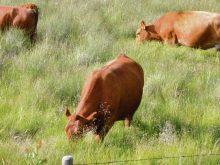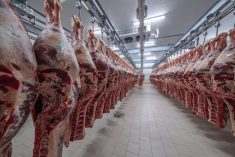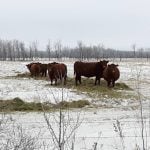Chicago Mercantile Exchange hog futures ended mixed on Wednesday amid pressure from weaker cash prices while concerns about the spread of a fatal piglet disease lent support, analysts and traders said.
December hogs settled at a premium to the CME’s lean hog index of 82.25 cents, which also dragged on the contract (all figures US$).
Front month December hogs, which expires Dec. 18, ended down 1.36 per cent, or 1.15 cents, at 83.675 cents per pound. February hogs closed up 0.025 cents, or 0.03 per cent, at 89 cents.
Traders said cash hog prices declined as pork packer demand slowed. Midwest hog brokers said most packers had supply needs met for week.
Read Also

U.S. grains: Soybean futures rise on active Chinese buying
Chicago | Reuters – U.S. soybean futures edged higher on Friday on increased Chinese demand for American supplies. Wheat and…
The U.S. Department of Agriculture Wednesday afternoon quoted the closely watched Iowa/Minnesota hog market down $1.82 per hundredweight (cwt) from Tuesday to $78.51.
Record heavy weight hogs also pressured CME hog futures. Analysts said less expensive corn has aided hog weight gains in recent weeks.
The average hog weight for the Thanksgiving holiday-shortened week ended Saturday was 281.7 lbs., up 0.3 lb. from the previous week and up 6.5 lbs. from a year earlier. Hog weights in the region marked a record high for the fifth straight week.
“Weights are high and the hog runs should be dropping off shortly after Thanksgiving,” said Doug Houghton, livestock analyst at Brock Associates.
Concerns regarding porcine epidemic diarrhea virus (PEDv), a fatal disease for baby pigs, lent support to deferred month contracts. Analysts and traders expected spring and early summer slaughter supplies to decline due to the spread of the disease, but by how much remains unclear.
“We’re also coming up to the time where we’re looking at the impact of the PEDv. The number of positive cases continue to rise,” Houghton said.
CME cattle edge higher
CME live cattle futures settled higher in anticipation of at least steady cash prices this week, traders said.
They said firm wholesale beef prices and tight numbers of market-ready cattle for sale were seen as supportive to live cattle futures.
Feedlot sources in the U.S. Plains said cattle were priced at $134 to $135/cwt, while packers have yet to bid. Last week cattle mostly sold at $132/cwt.
Moderate retail demand lent support to the wholesale beef price, analysts said. USDA’s Wednesday afternoon wholesale beef price was $203.30/cwt for choice cuts, up 30 cents from Tuesday. Select cuts rose nine cents to $190.04/cwt.
“Beef demand has been decent despite high prices,” Houghton said.
Sub-zero temperatures and blowing snow are expected for the U.S. Plains and portions of the Midwest late Wednesday and into the weekend, an agricultural weather forecaster said.
The extreme cold will likely slow cattle weight gains while the blowing snow has potential to snarl traffic which can stall movement.
December live cattle futures settled up 0.2 cent at 132.725 cents/lb. February cattle settled up 0.325 cent at 134.425 cents.
Feeder cattle futures settled slightly higher following live cattle futures. Front month January traded at a discount to the CME’s feeder index of 166.53 cents per lb, which lent support to the front-month contract.
January feeder cattle settled up 0.2 cent at 165.05 cents/lb., and March ended up 0.1 cent at 165.35 cents.
— Meredith Davis reports on U.S. ag commodities for Reuters from Chicago.














